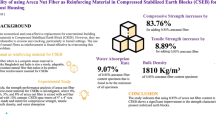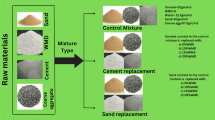Abstract
In rapid urbanization, the construction of mechanically stabilized earthen (MSE) walls has found its inevitable part for which the natural backfill material is becoming scarce. Urbanization can itself answer this problem of scarcity if proper utilization of construction and demolition waste (CDW) is made possible. Proper detailed characterization is necessary to find the suitability of the material as an alternative for depleting natural sand. CDW material processing is minimal all around the world and the characteristics of the processed material vary from place to place. Characterization of various fractions of the CDW material collected from a waste processing unit in India is done by detailed experimental investigations. The results are compared with standard regulations to find the suitability of using the heterogeneous mixture of CDW material, as fill material in MSE walls. From the comparison, it was found that two different fractions of CDW material can be utilized as backfill of geosynthetic-reinforced MSE walls. Further, numerical modeling of an MSE wall was done using finite element program Plaxis. The deformation and stress–strain response of MSE wall backfilled with various fractions of CDW were promising. For Fraction 3 and Fraction 4 CDW, the deformation is reduced by 23% and 86%, respectively, compared to ideal backfill material. Present research highlights a sustainable way of managing the waste generated from the construction and demolition activities focusing on value addition of the material utilizing as a backfill of geosynthetic-reinforced MSE walls.













Similar content being viewed by others
Data availability
All data generated or analysed during this study are included in this published article.
References
Christopher BR, Gill S, Giroud JP, Juran I, Mitchell K, Schlosser F, Dunnicliff J (1990) Reinforced soil structures, vol I. Design and construction guidelines (no. FHWA-RD-89-043)
National Concrete Masonry Association (2010) Design manual for segmental retaining walls. National Concrete Masonry Association, Herndon
BS. 8006-1 (1995) Code of practice for strengthened/reinforced soils and other fills. British Standards, London
Vibha S, Divya PV (2019) Deformation behavior of reinforced soil slopes subjected to rainfall-induced subsidence. ISSMGE TC107 laterites and lateritic soils, pp 87–94
Jayanandan M, Viswanadham BVS (2020) Geogrid reinforced soil walls with marginal backfills subjected to rainfall: numerical study. Indian Geotech J 50(2):238–251
EPA (2019). Sustainable management of construction and demolition materials. http://www.epa.gov/smm/sustainablemanagement-construction-and-demolition-materials
Vibha S, Divya PV (2021) Geosynthetic-reinforced soil walls with sustainable backfills. Indian Geotech J 51(6):1135–1144
Yang H, Xia J, Thompson JR, Flower RJ (2017) Urban construction and demolition waste and landfill failure in Shenzhen, China. Waste Manag 63:393–396
Vieira CS, Pereira PM (2015) Use of recycled construction and demolition materials in geotechnical applications: a review. Resour Conserv Recycl 103:192–204
Ossa A, García JL, Botero E (2016) Use of recycled construction and demolition waste (CDW) aggregates: a sustainable alternative for the pavement construction industry. J Clean Prod 135:379–386
Puthussery JV, Kumar R, Garg A (2017) Evaluation of recycled concrete aggregates for their suitability in construction activities: an experimental study. Waste Manag 60:270–276
Silva RV, De Brito J, Dhir RK (2019) Use of recycled aggregates arising from construction and demolition waste in new construction applications. J Clean Prod 236:117629
Revilla-Cuesta V, Skaf M, Chica JA, Fuente-Alonso JA, Ortega-López V (2020) Thermal deformability of recycled self-compacting concrete under cyclical temperature variations. Mater Lett 278:128417
Silva RV, De Brito J, Dhir RK (2014) Properties and composition of recycled aggregates from construction and demolition waste suitable for concrete production. Constr Build Mater 65:201–217
Rao A, Jha KN, Misra S (2007) Use of aggregates from recycled construction and demolition waste in concrete. Resour Conserv Recycl 50(1):71–81
Kashyap R, Saxena M, Gautam A, Chauhan S, Mourya A, Verma P (2022) A study on recycled lightweight aggregate concrete. J Build Pathol Rehabil 7(1):1–11
Mehrjardi GT, Azizi A, Haji-Azizi A, Asdollafardi G (2020) Evaluating and improving the construction and demolition waste technical properties to use in road construction. Transport Geotech 23:100349
Cardoso R, Silva RV, de Brito J, Dhir R (2016) Use of recycled aggregates from construction and demolition waste in geotechnical applications: a literature review. Waste Manag 49:131–145
Mohammadinia A, Arulrajah A, Horpibulsuk S, Shourijeh PT (2019) Impact of potassium cations on the light chemical stabilization of construction and demolition wastes. Constr Build Mater 203:69–74
Mohammadinia A, Naeini M, Arulrajah A, Horpibulsuk S, Leong M (2020) Shakedown analysis of recycled materials as railway capping layer under cyclic loading. Soil Dyn Earthq Eng 139:106423
Arulrajah A, Disfani MM, Horpibulsuk S, Suksiripattanapong C, Prongmanee N (2014) Physical properties and shear strength responses of recycled construction and demolition materials in unbound pavement base/subbase applications. Constr Build Mater 58:245–257
Anita A, Karthika S, Divya PV (2023) Construction and demolition waste as valuable resources for geosynthetic-encased stone columns. J Hazard Toxic Radioact Waste 27(2):04022047
Chen K, Wang J, Yu B, Wu H, Zhang J (2021) Critical evaluation of construction and demolition waste and associated environmental impacts: a scientometric analysis. J Clean Prod 10(287):125071
Islam R, Nazifa TH, Yuniarto A, Uddin AS, Salmiati S, Shahid S (2019) An empirical study of construction and demolition waste generation and implication of recycling. Waste Manag 95:10–21
Ok B, Sarici T, Talaslioglu T, Yildiz A (2020) Geotechnical properties of recycled construction and demolition materials for filling applications. Transport Geotech 1(24):100380
Sharma A, Shrivastava N (2023) Geotechnical characterization of construction and demolition waste material blended with sandy soil. Int J Geosynth Ground Eng 9(4):43
Alexander M, Beushausen H (2019) Durability, service life prediction, and modelling for reinforced concrete structures–review and critique. Cem Concr Res 122:17–29
Tappin S (2002) The early use of reinforced concrete in India. Construct Hist 18:79–98
ASTM D6913-04 (2009) Standard test methods for particle-size distribution (gradation) of soils using sieve analysis, ASTM International, West Conshohocken
ASTM D442-63 (2007) Standard test method for particle-size analysis of soils. ASTM International, West Conshohocken
ASTM G51-95 (2005) Standard test method for measuring the pH of soil for use in corrosion testing. ASTM International, West Conshohocken
ASTM D854-14 (2014) Standard test methods for specific gravity of soil solids by water pycnometer. ASTM International, West Conshohocken
ASTM D7181-20 (2020) Standard test method for consolidated drained triaxial compression test for soils. ASTM International, West Conshohocken
ASTM D3080/D3080M-11 (2012) Standard test method for direct shear test of soils under consolidated drained conditions. ASTM International, West Conshohocken
ASTM D698-12 (2021) Standard test methods for laboratory compaction characteristics of soil using standard effort. ASTM International, West Conshohocken
ASTM D2434-19 (2019) standard test method for permeability of granular soils (constant head). ASTM International, West Conshohocken
ASTM C127-12 (2012) Standard test method for density, relative density (specific gravity), and absorption of coarse aggregates. ASTM International, West Conshohocken
IRC SP 116 (2018) Guidelines for design and installation of gabion structures. Indian Roads Congress, India
Hardin BO (1985) Crushing of soil particles. J Geotech Eng 111(10):1177–1192
IRC SP 102 (2014) Guidelines for design and construction of reinforced soil walls. Indian Roads Congress, India
American Association of state highway and transportation officials (AASTHO) (2002) Interims to standard specification for highway bridges. AASTHO, Washington
Hatami K, Bathurst RJ (2005) Development and verification of a numerical model for the analysis of geosynthetic-reinforced soil segmental walls under working stress conditions. Can Geotech J 42(4):1066–1085
Duncan JM, Chang CY (1970) Nonlinear analysis of stress and strain in soils. J Soil Mech Found Div 96(5):1629–1653
Schanz T, Vermeer PA, Bonnier PG (1999) The hardening soil model: formulation and verification. Beyond 2000 Comput Geotech 1:281–296
Funding
This research was funded by the TDT division, Ministry of Science and Technology, Department of Science and Technology, Govt. of India and their financial support is highly acknowledged (Project no. DST/TDT/WM/2022/118).
Author information
Authors and Affiliations
Contributions
All authors contributed to the study conception and design. Material preparation, data collection, experimental investigation, and analysis were performed by Ms. Anita A under the guidance of Dr. P.V. Divya. All authors read and approved the final manuscript.
Corresponding author
Ethics declarations
Conflict of interest
The authors have no financial or proprietary interests in any material discussed in this article.
Additional information
Publisher's Note
Springer Nature remains neutral with regard to jurisdictional claims in published maps and institutional affiliations.
Rights and permissions
Springer Nature or its licensor (e.g. a society or other partner) holds exclusive rights to this article under a publishing agreement with the author(s) or other rightsholder(s); author self-archiving of the accepted manuscript version of this article is solely governed by the terms of such publishing agreement and applicable law.
About this article
Cite this article
Anita, A., Divya, P.V. Construction and Demolition Waste as a Sustainable Backfill for Geosynthetic-Reinforced MSE Walls. Int. J. of Geosynth. and Ground Eng. 10, 36 (2024). https://doi.org/10.1007/s40891-024-00539-1
Received:
Accepted:
Published:
DOI: https://doi.org/10.1007/s40891-024-00539-1




